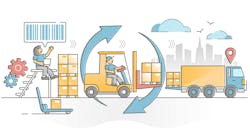In the last few months, it’s been hard to avoid hearing about generative AI. Tools like ChatGPT and DALL-E have shown impressive results in generating whatever text and images, respectively, that the user desires. In fact, this paragraph was written by ChatGPT.
Many tech prognosticators have predicted that these generative AI tools will have a massive disruptive impact across industries—particularly industries that deal with text and images such as media, marketing and legal industries. What’s less apparent is how generative AI will impact the material handling and logistics industries.
After all, other than peripheral business functions like marketing and legal, there’s not much that those involved in the logistics of the supply chain have to do with text and images. However, generative AI can do much more than generate text and images. It can also be used to generate solutions to complex business problems, particularly optimization problems that are widespread in logistics.
In general, optimization problems seek to find the best possible solution according to some criteria among a wide range of possible solutions. A generative model could be trained on the best existing solutions to an optimization problem, learning what qualities make for good candidate solutions. This generative model then generates new solutions.
These could include finding more efficient routes for shipping networks, optimizing the organizational design of warehouses to speed up order-picking, or selecting the best combination of suppliers, distributors and vendors to maximize product quality and demand coverage while minimizing costs and delivery times. In an industry as complex as logistics, the potential for optimization is staggering.
That all sounds great. But discerning readers may remember that for years quantum computing has also been heralded as a silver bullet for optimization problems—with an advantage yet to materialize. As it turns out, not only may generative AI be the fastest avenue to realize that advantage in quantum optimization, but it may also be the first domain we see practical quantum advantage in general.
Quantum Computing and Generative AI
At a high level, generative models like ChatGPT work by feeding the models massive amounts of data. The models then learn the patterns in the data to produce similar but novel data based on what is most probable in the training datasets. In other words, the models learn to replicate the essential features that characterize the data they’re trained on.
Quantum computers’ potential advantage in generative modeling comes from their ability to encode and sample from complex probability distributions in the training data in a way that would not be feasible on classical computers. There are a few reasons for this, namely the quantum phenomena of entanglement, which can be used to encode distant correlations within a complex dataset in ways that could be difficult to simulate with classical computers. Furthermore, quantum computers can be easily adapted for sampling tasks due to the inherent probabilistic nature associated with measuring a quantum state.
Ultimately, this results in an ability to generate a more diverse range of solutions to the generative modeling task. In the case of generative modeling for optimization, this property would allow quantum generative models to generate new solutions that were previously unconsidered.
The catch is that we are still in the era of limited-qubit, error-prone quantum devices, which limit their usefulness at the moment. Fortunately, quantum-inspired generative models, based on tensor networks and running on classical computers, can provide an advantage in generative modeling today—particularly for optimization. What’s more, these tensor network-based models can be mapped directly onto real quantum circuits, making them forward compatible to run on more powerful quantum hardware in the future.
This quantum-inspired generative modeling approach is on par with many of the optimization solvers available today. In a financial portfolio optimization problem, for example, a generator-enhanced optimization (GEO) approach was as good or better than 65% of the best-in-class solutions. There are several instances where GEO showed it could outperform existing solvers for a plant scheduling optimization problem in collaboration with BMW and MIT.
Quantum-inspired models have shown value for optimization problems with equality constraints—in other words, problems where conditions must be satisfied exactly for a solution to be valid. Traditional heuristic optimizers, both classical and quantum, generate many solutions that do not satisfy these constraints, which makes for expensive and inefficient searches.
In contrast, equality constraints can be encoded directly into a tensor network in a way that only outputs valid samples, exponentially increasing the likelihood of finding good solutions. This constrained tensor network approach has outperformed its standard unconstrained counterparts in finding novel and higher quality solutions to combinatorial optimization problems. What’s more, while traditional methods can suffer when equality constraints are added, this new approach actually benefits from more constraints, delivering better computational performance at a cheaper computational cost.
Use Cases for GEO in Logistics
Optimization problems like the plant scheduling problem we demonstrated with BMW abound in the material handling and logistics industries. Below are a few examples of problems where generative AI could be deployed to find new and possibly better solutions:
Supply Chain Optimization: Optimizing the selection of suppliers, distributors and vendors to maximize product quality and demand coverage while minimizing costs and delivery times.
Reverse Logistics Optimization: Optimizing the scheduling of logistics networks for recycling, reuse, disposal and product recalls to minimize costs.
Facility Location Optimization: Optimizing the location of facilities in the supply chain for capacitated and uncapacitated systems to reduce costs associated with construction and transportation.
Inventory Policy Optimization: Designing inventory policies optimized for minimizing costs across multiple product families.
Workforce Scheduling Optimization: Optimizing workforce scheduling to balance workloads for multi-commodity teams while minimizing labor costs.
Warehouse Optimization: Optimizing the design of warehouses as well as order-picking, scheduling and routing to increase efficiency.
Delivery Routing Optimization: Optimizing vehicle routing for delivery operations to reduce costs and shorten delivery times.
There may be additional use cases that are unique to your business. Ultimately, the only way to know whether quantum or quantum-inspired generative models can provide an advantage for solving these problems—and the potential value at stake—is to try it. The field of generative AI for optimization is still in its infancy, and by building and deploying these generative AI applications for your unique business problems, we may discover new techniques that lead to further advantages.
The other benefit of building generative AI applications for optimization today with quantum-inspired models is that these models are forward-compatible with quantum computation. So not only may businesses gain an edge in optimization problems today, but they would also be primed to potentially reach a greater advantage as quantum hardware matures—in essence, becoming quantum-ready.
Applying generative AI for logistical optimization problems could have dramatic impacts for the logistics industry: not only could it reduce manufacturing, shipping and handling costs and accelerate the flow of the supply chain, it could reduce waste and cut carbon emissions as well. For businesses looking for areas to reduce their carbon footprint, optimizing their supply chain is a good place to start.
Jhonathan Romero Fontalvo is director of professional services and co-founder of Zapata Computing, an enterprise software company for quantum solutions.



